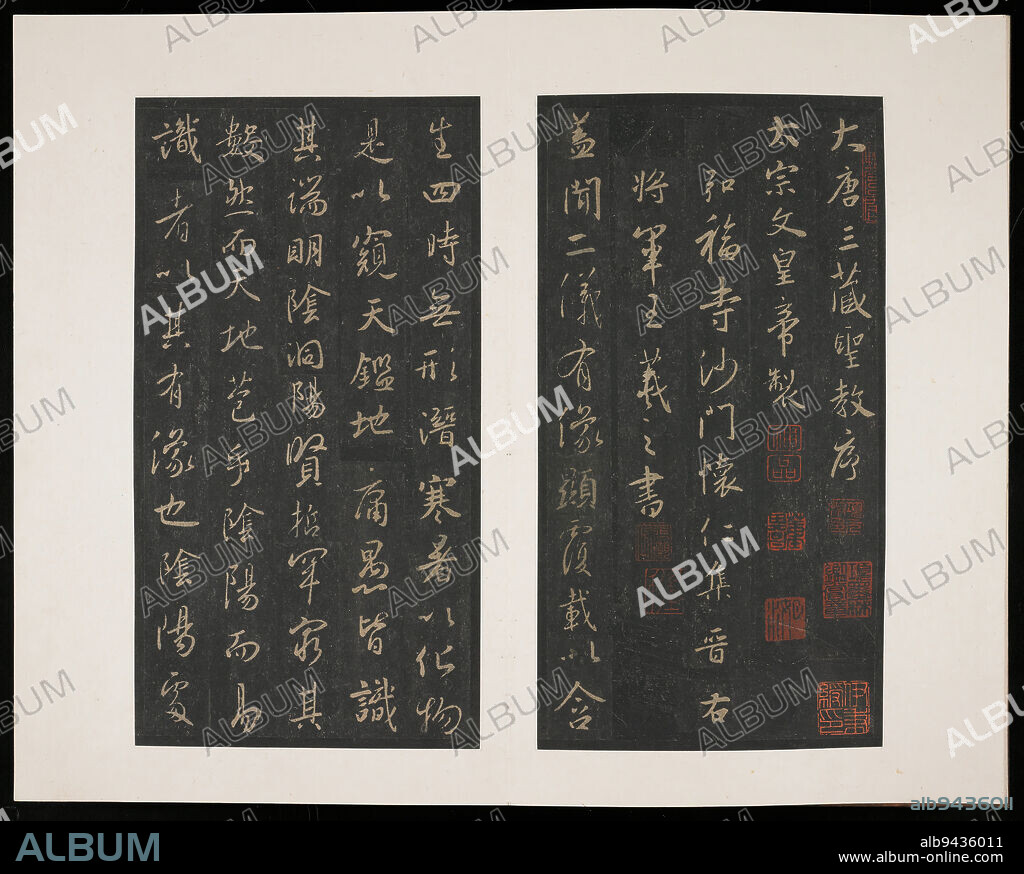alb9436011
Rubbings of the Sheng-chiao hsu Stele, 12th century, Wang Hsi-chih, Chinese, 303 - 361, 1 3/8 x 8 1/2 x 13 1/2 in. (3.49 x 21.59 x 34.29 cm), Ink on paper, China, 12th century, Wang Hsi-chih, one of the greatest calligraphers of all times, was undoubtedly the primary cultural prototype for the Ming literati. Wang came from an aristocratic family and preferred the company of Taoist and Buddhist monks to Confucian bureaucrats. A brilliant man of letters, he studied poetry, music, and calligraphy and sought the quietude of nature. Wang was a master of running script (hsing-shu) calligraphy. His innovative brush movements distinguished his work from the rigid and formal style of archaic clerical script. Wang's spontaneous, fluid writing served as the model for expressive calligraphy for centuries to come.

|
Add to another lightbox |
|
Add to another lightbox |



Caption:
Rubbings of the Sheng-chiao hsu Stele, 12th century, Wang Hsi-chih, Chinese, 303 - 361, 1 3/8 x 8 1/2 x 13 1/2 in. (3.49 x 21.59 x 34.29 cm), Ink on paper, China, 12th century, Wang Hsi-chih, one of the greatest calligraphers of all times, was undoubtedly the primary cultural prototype for the Ming literati. Wang came from an aristocratic family and preferred the company of Taoist and Buddhist monks to Confucian bureaucrats. A brilliant man of letters, he studied poetry, music, and calligraphy and sought the quietude of nature. Wang was a master of running script (hsing-shu) calligraphy. His innovative brush movements distinguished his work from the rigid and formal style of archaic clerical script. Wang's spontaneous, fluid writing served as the model for expressive calligraphy for centuries to come.
Credit:
Album / quintlox
Releases:
Model: No - Property: No
Rights questions?
Rights questions?
Image size:
5155 x 4131 px | 60.9 MB
Print size:
43.6 x 35.0 cm | 17.2 x 13.8 in (300 dpi)
Keywords:
12 CENTURY • 12TH CENTURY • 303-361 • ARCHAIC CLERICAL SCRIPT • ARISTOCRATIC FAMILY • BRILLIANT MAN • BUDDHIST MONKS • CALLIGRAPHY • CENTURIES • CHINA • CHINE • CHINESE • CÔME • COMPANY • CONFUCIAN BUREAUCRATS • EXPRESSIVE CALLIGRAPHY • FLUID WRITING SERVED • FORMAL STYLE • GREATEST CALLIGRAPHERS • HSING-SHU • INK ON PAPER • INNOVATIVE BRUSH MOVEMENTS DISTINGUISHED • LETTERS • MASTER • MING LITERATI • MODEL • MUSIC • NATURE • PORCELAIN • PREFERRED • PRIMARY CULTURAL PROTOTYPE • QUIETUDE • RIGID • RUBBINGS • RUNNING SCRIPT • SHENG-CHIAO HSU STELE • STUDIED POETRY • TAOIST • TIMES • UNDOUBTEDLY • WANG CAME • WANG HSI-CHIH • WANG'S SPONTANEOUS • WANG • WILDERNESS • WORK
 Pinterest
Pinterest Twitter
Twitter Facebook
Facebook Copy link
Copy link Email
Email

